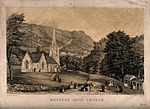Cromford

Cromford () is a village and civil parish in Derbyshire, England, in the valley of the River Derwent between Wirksworth and Matlock. It is 17 miles (27 km) north of Derby, 2 miles (3.2 km) south of Matlock and 0.5 miles (0.80 km) south of Matlock Bath. It is first mentioned in the 11th-century Domesday Book as Crumforde, a berewick (supporting farm) of Wirksworth, and this remained the case throughout the Middle Ages. The population at the 2011 Census was 1,433. It is principally known for its historical connection with Richard Arkwright and the nearby Cromford Mill, which he built outside the village in 1771. Cromford is in the Derwent Valley Mills World Heritage Site. The Cromford mill complex, owned and being restored by the Arkwright Society, was declared by Historic England as "one of the country’s 100 irreplaceable sites". It is also the centrepiece of the Derwent Valley Mills UNESCO World Heritage Site. In 2018, the Cromford Mills Creative Cluster and World Heritage Site Gateway Project was listed as a finalist for the Best Major Regeneration of a Historic Building or Place in the Historic England Angel Awards.
Excerpt from the Wikipedia article Cromford (License: CC BY-SA 3.0, Authors, Images).Cromford
The Hill, Derbyshire Dales
Geographical coordinates (GPS) Address Nearby Places Show on map
Geographical coordinates (GPS)
| Latitude | Longitude |
|---|---|
| N 53.108 ° | E -1.561 ° |
Address
The Hill 7
DE4 3RF Derbyshire Dales
England, United Kingdom
Open on Google Maps










